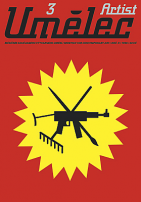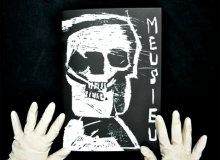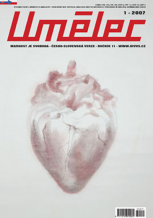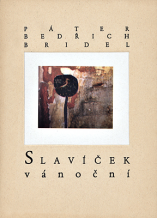| Umělec magazine 1998/3 >> Satan’s and Other Art in Istanbul | List of all editions. | ||||||||||||
|
|||||||||||||
Satan’s and Other Art in IstanbulUmělec magazine 1998/301.03.1998 Tomáš Pospiszyl | turkey | en cs |
|||||||||||||
|
"Considering responses to my last article in the Artist magazine dealing with touristic criticism and despite my critical rejection of this type of critique, I have decided to continue in this direction. Having spent three days in Istanbul, I feel ready to write an article on contemporary Turkish art. I have to admit, however, that I had read something about Turkish art in advance and I know several contemporary artists in person. Furthermore, one of the two most known Turkish curators is a friend of mine.
I arranged to meet curator Vasif Kortun on the Taksim Square, Istanbul’s commercial center. Placed in the middle of this square is a statue of the founder of Turkish State with commanders and generals standing by a cannon. “Could you guess what makes this memorial special,“ Vasif asked me. I didn’t understand why this traditional and academic looking memorial made after the 19th Century definition should be immediately interesting. “This memorial was built in the 20‘s,“ Vasif explained. “The author is a nearly forgotten French artist. He was commissioned to do the statue because there was not a single figurative sculptor in Turkey in the 20‘s who would be able to take up such task. After centuries of Islamic laws’ rule, this was the first public three-dimensional image of a human body. It was a scandal in Islamic society and those who made a decision to erect it were very much aware of what would happen. The memorial was from the start intended as a slap in the face of traditional Islamic society.“ Right the first day, I unexpectedly found out how an academic statue may become a controversial piece of work in some countries. Recent Turkish history is full of social engineering and in many respects it is similar to our experience during the past forty years of Communism and our difficult transformation to modern civilization of western type. The city that is today called Istanbul has a rich history partly resulting from its unique location between two continents, becoming a place of connecting and segregating different cultures. The following outline of some of the historical moments may help draw very general perspective of this city and the art that has been made here for centuries and is being made today. In the middle of the fifth century, Daniel, a monk, arrived in the city. His life may appear to us today as a work by an action artist. Daniel settled on top of a tall pole where he stayed until he died 33 years after he had voluntarily decided to live above ground in isolation. The emperor then decided to build another pole next the original one so that Daniel could move at least between the two. After his death, his body was attached to a board and for a period of time it was worshipped as an icon until it finally touched the ground in a grave. The iconoclast movement just like the entire Christianity also influenced the city’s history. Its official beginning dates back to year 726 when Leo III ordered that the Christ’s painting is removed from the cathedral. Leo claimed that worshipping paintings was not in accord with Christianity and he later declared that paintings might not exist at all in the country. In 1453, the city was conquered by the Turks and since than it has kept its Moslem character. Islamic art is no less fascinating than European art, although its forms are different from ours. Similarly to iconoclasts, Islam rejects an image of a human figure and goes further in this prohibition. Prophet Mohammed personally removed statues from the cathedral in Mecca and Koran literally describes statues as a work of Satan. One may recognize it by the fact that they cast shadows. On the other hand, imagery was acceptable if part of a utility object. Islamic art is based on an ornament and decoration if we are able to perceive it without a derogatory tone in our culture (if not, the word abstract may help out). Carpets, traditionally produced by women in the region represent one of the most beautiful expressions of Islamic art. Their beautiful and complex patterns are comparable with any European art. The ornaments used in them are derived from local traditions but their ancient predecessors may be traced down to antique times. In the 19th century, sultan Mahmut II initiated massive modernization of the country. He forbid wearing complicated turbans as a symbol of the old times and replaced with a light fez. During his reign from 1923 to 1938, Atatürk, the founder of the Turkish State, strived to place Turkey into the western civilization. We may say today that he has reached major success in his efforts. He fought Islamic religion, which was strictly separated from the state; he cancelled religious schools and suppressed traditional customs and culture. He replaced Arabic alphabet with Latin writing and he prohibited wearing fez’s as a symbol backwards thinking. Together with the Czech Republic, Turkey is one of the most secular states. In today’s Istanbul, you may see people wear anything from turbans, fez’s, hats, caps to bear heads. This truly postmodern atmosphere provides good basis for art, although the local art scene is much smaller and more peripheral than it is in Prague. At the moment, Istanbul has three commercial galleries and one non-profit gallery with a steady contemporary art program. The city, however, lacks a museum of modern art. Also, there isn’t any magazine that would report on contemporary art. Before World War II, Turkish artists were leaving for Paris where they made their works and then sold them back home in Turkey. Some artists still go and live in France, New York or Scandinavia for a while. In global context, the Istanbul Biennial has grown to an important event yet it is visited more by foreign than local audience. The 80‘s in Turkey were in the name of derived neoexpressionist painting. 1989 and the end of the Cold War was just as significant turning point for Turkish artists as for Czech artists. Turkey used to be a closed country that didn’t communicate with other states. This situation started to change quickly. The 80‘s represented an intense inflow of foreign capital and that what was left from the old culture and had not been destroyed by modernization in the 30‘s soon gave in to culture of multinational monopolies. Many Turks replaced their traditional quisine with hamburgers, increase of the number of automobiles and decreasing job opportunities in villages turned people into involuntary nomads without a home. The country was also attacked by western style advertising, something local culture was not able to deal with. Bulent Sangar, an artist, responded to this situation in several of his works. He cuts painfully into the tissue of our personal lives growing together with the unreal world of ad photographs. In a cycle of photographs, he wears Levi’s 501 making various army exercises. In another cycle, he created a sort of new prayer handbook. A figure dressed in jeans demonstrates positions one takes during a Moslem prayer, movements that were forcefully removed and forgotten thanks to people’s self-indulgence. Underdeveloped local art market, however, shows also its brighter side. In addition to common grief over their fate, artists in Turkey appreciate the fact they do not have to adapt to commercial pressures and the limited possibilities to show their work do not force them to senselessly produce new art works without being convinced of their necessity. Another interesting feature of Turkish art lies in the fact that there does not exists any competition between men and women as we know it from our art. Female artists slightly prevail but the overall number of artists is so small that a group exhibition naturally shows both men and women who complement each other rather than dispute each other. One of the best known Turkish contemporary artists is also a woman. Hale Tanger studied in London but has lived and worked in Istanbul for many years. She was represented on the 3rd and 4th international Istanbul Biennials in 1992 and 1995 respectively. Her debut immediately led to a lawsuit. Peaks of her career so far include an exhibition in The New Museum of Contemporary Art in New York in 1996 and the first Manifesta in Rotterdam. In her work, Tanger is interested in politics both local and international. Most of her work is based on compiling various elements into assemblage statues or internationally understandable installations. Some of her more ambitious projects are in fact completely furnished interiors that a viewer may walk through. In these often ready-mades in part, Tanger creates effective and dreamy atmosphere of the given space, using light and sound. Works by Inci Eviner represent more traditional approach from a European perspective. She tries to additionally illustrate Mongolian mythology, local tales and legends, mixing it all with post-modern philosophy. Perhaps thanks to their unusual format, her works are indeed closer to notes than painting. While drawings and graphics by Melek Mazici are based on a similar principle of assembling various elements into a collage, their effect often reminds botanical preparations, scientific drawings from atlases or dried flowers forgotten in books. The coal drawings with thick light and darks contrasts which are not always usual for techniques used by Mazici suggest matter and weight of depicted objects. None of the three artists is working with direct image of a human body, instead it is represented only in the form of fragments. Macka Art Gallery is perhaps the most peculiar Istanbul gallery. Operating for the past 20 years, the gallery’s interior is covered with tiles 10x10cm. The impression one gets is as if one walks into a public toilet or a hallway of a swimming pool. Yet artists do show their work, including hung paintings. This space, however, makes it impossible not to respond to the net structure created by the tiles. The interior is closer to European radical modernism than local tradition of tile decoration. Most of the Macka projects are therefore tailor-made as a response to the gallery’s radical architecture. Art in Istanbul stands on two and perhaps even more continents. It is surprising how little it draws on rich tradition of local art or it refers to it in a very derived manner. Turkey is not threatened, or at least I was assured of it, by fundamentalist movements like Algeria or Iran. Everything goes even though the country is in a state that the Turks call permanent catastrophe. Those are the conditions under which Turkish artists makes their work. Contacts with this exotic yet in fact surprisingly familiar environment would be certainly instructive and beneficial for both parties. "
01.03.1998
Recommended articles
|
|||||||||||||
|
04.02.2020 10:17
Letošní 50. ročník Art Basel přilákal celkem 93 000 návštěvníků a sběratelů z 80 zemí světa. 290 prémiových galerií představilo umělecká díla od počátku 20. století až po současnost. Hlavní sektor přehlídky, tradičně v prvním patře výstavního prostoru, představil 232 předních galerií z celého světa nabízející umění nejvyšší kvality. Veletrh ukázal vzestupný trend prodeje prostřednictvím galerií jak soukromým sbírkám, tak i institucím. Kromě hlavního veletrhu stály za návštěvu i ty přidružené: Volta, Liste a Photo Basel, k tomu doprovodné programy a výstavy v místních institucích, které kvalitou daleko přesahují hranice města tj. Kunsthalle Basel, Kunstmuseum, Tinguely muzeum nebo Fondation Beyeler.
|

































 New book by I.M.Jirous in English at our online bookshop.
New book by I.M.Jirous in English at our online bookshop.
Comments
There are currently no comments.Add new comment